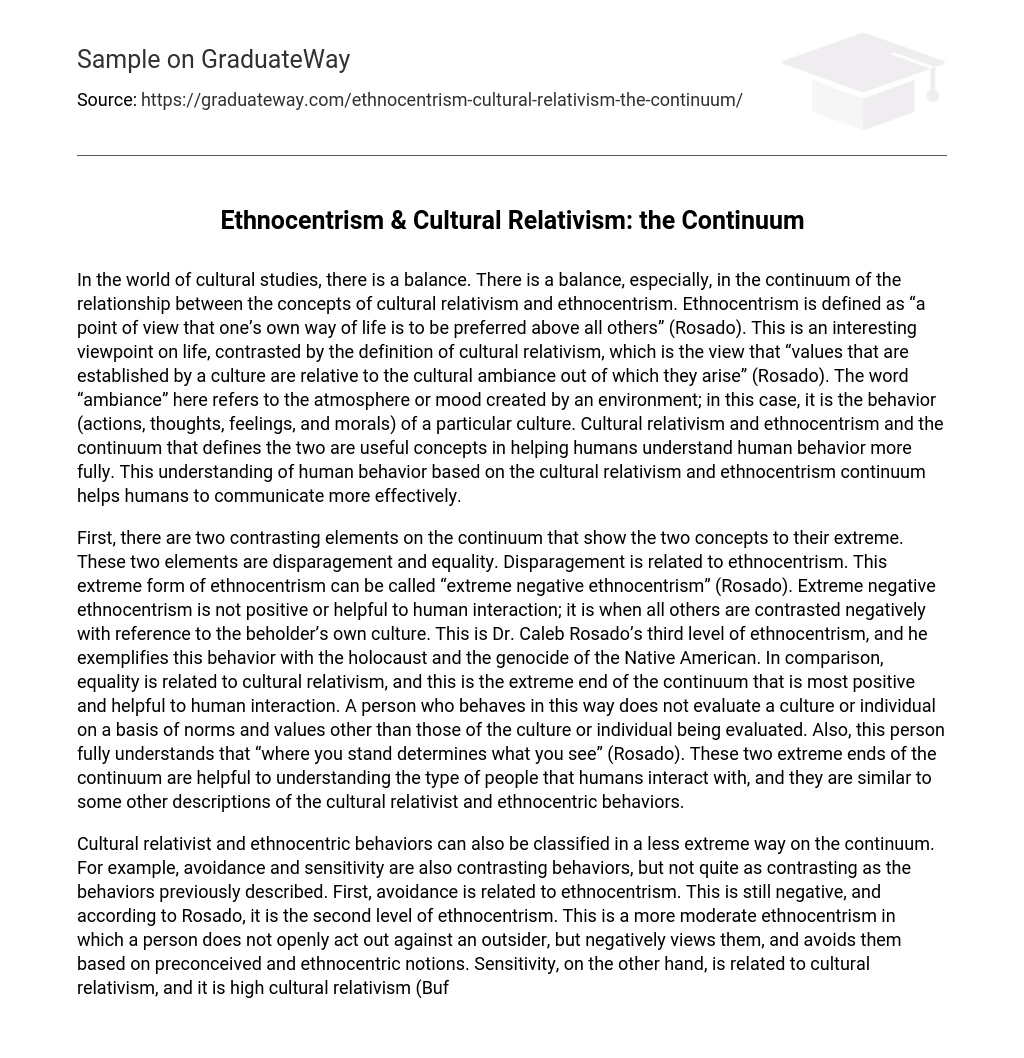In the world of cultural studies, there is a balance. There is a balance, especially, in the continuum of the relationship between the concepts of cultural relativism and ethnocentrism. Ethnocentrism is defined as “a point of view that one’s own way of life is to be preferred above all others” (Rosado). This is an interesting viewpoint on life, contrasted by the definition of cultural relativism, which is the view that “values that are established by a culture are relative to the cultural ambiance out of which they arise” (Rosado). The word “ambiance” here refers to the atmosphere or mood created by an environment; in this case, it is the behavior (actions, thoughts, feelings, and morals) of a particular culture. Cultural relativism and ethnocentrism and the continuum that defines the two are useful concepts in helping humans understand human behavior more fully. This understanding of human behavior based on the cultural relativism and ethnocentrism continuum helps humans to communicate more effectively.
First, there are two contrasting elements on the continuum that show the two concepts to their extreme. These two elements are disparagement and equality. Disparagement is related to ethnocentrism. This extreme form of ethnocentrism can be called “extreme negative ethnocentrism” (Rosado). Extreme negative ethnocentrism is not positive or helpful to human interaction; it is when all others are contrasted negatively with reference to the beholder’s own culture. This is Dr. Caleb Rosado’s third level of ethnocentrism, and he exemplifies this behavior with the holocaust and the genocide of the Native American. In comparison, equality is related to cultural relativism, and this is the extreme end of the continuum that is most positive and helpful to human interaction. A person who behaves in this way does not evaluate a culture or individual on a basis of norms and values other than those of the culture or individual being evaluated. Also, this person fully understands that “where you stand determines what you see” (Rosado). These two extreme ends of the continuum are helpful to understanding the type of people that humans interact with, and they are similar to some other descriptions of the cultural relativist and ethnocentric behaviors.
Cultural relativist and ethnocentric behaviors can also be classified in a less extreme way on the continuum. For example, avoidance and sensitivity are also contrasting behaviors, but not quite as contrasting as the behaviors previously described. First, avoidance is related to ethnocentrism. This is still negative, and according to Rosado, it is the second level of ethnocentrism. This is a more moderate ethnocentrism in which a person does not openly act out against an outsider, but negatively views them, and avoids them based on preconceived and ethnocentric notions. Sensitivity, on the other hand, is related to cultural relativism, and it is high cultural relativism (Buff. St). This is when a person understands and acts accordingly with a cultural relativist mindset, but does not openly act free of basic human mistrust and discomfort from individuals from another culture. A person acting with sensitivity can be considered a critical thinker. The contrast of these ideals and behaviors on this continuum helps to show important information about how humans behave. More information can be shown through comparing the similarities in the middle of the continuum.
The third and final aspect of the continuum is the concept of indifference. This concept is essentially moderate ethnocentrism mixed with moderate cultural relativism. Indifference leaves room for plenty of gray area on the continuum, which is visible in human behavior throughout the world. Related to ethnocentrism, Rosado says that it is positive. It is an ethnocentric view with understanding and practice of cultural relativist behavior. This moderate level of ethnocentrism comes from basic critical thinking skills and is not completely centered on the idea that their own culture does everything the way that all others should, but is still confident in the home culture. Similarly, indifference related to cultural relativism is positive. This person acts with a mindset synonymous with cultural relativist thoughts and ideals moderately, not entirely. A person behaving like this views cultures and people ethnocentrically in a moderate way also, not by lack of critical thinking skills, but by ignorance, cultural values, and basic human instinct.
Cultural relativism and ethnocentrism go hand in hand when it comes to understanding human behavior. In order to communicate more effectively, humans must understand human behavior more fully. By contrasting equality to disparagement and sensitivity to avoidance, a better understanding of human behavior emerges. By comparing and explaining indifference in relation to ethnocentrism and cultural relativism, an even better understanding of human behavior emerges. By understanding human behavior more fully with information like this, humans can more effectively communicate with each other.





